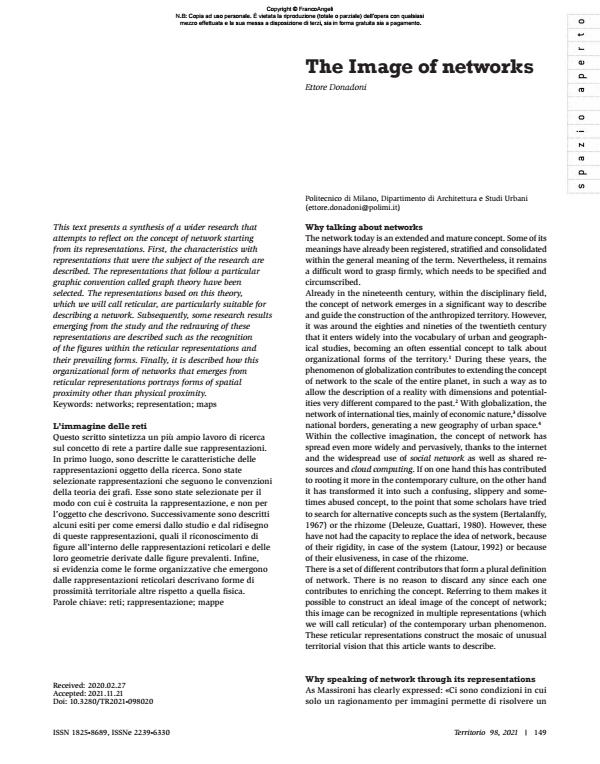The Image of networks
Journal title TERRITORIO
Author/s Ettore Donadoni
Publishing Year 2022 Issue 2021/98 Language English
Pages 22 P. 149-170 File size 1226 KB
DOI 10.3280/TR2021-098020
DOI is like a bar code for intellectual property: to have more infomation
click here
Below, you can see the article first page
If you want to buy this article in PDF format, you can do it, following the instructions to buy download credits

FrancoAngeli is member of Publishers International Linking Association, Inc (PILA), a not-for-profit association which run the CrossRef service enabling links to and from online scholarly content.
This text presents a synthesis of a wider research that attempts to reflect on the concept of network starting from its representations. First, the characteristics with representations that were the subject of the research are described. The representations that follow a particular graphic convention called graph theory have been selected. The representations based on this theory, which we will call reticular, are particularly suitable for describing a network. Subsequently, some research results emerging from the study and the redrawing of these representations are described such as the recognition of the figures within the reticular representations and their prevailing forms. Finally, it is described how this organizational form of networks that emerges from reticular representations portrays forms of spatial proximity other than physical proximity.
Keywords: networks; representation; maps
- Alexander C., 1965, «A City is Not a Tree». The Architectural Forum, 162: 58-62.
- Barabasi A., 2002, La scienza delle reti. Torino: Einaudi.
- Bertalanffy L.,1967, General System Theory. New York: George Braziller (trad. it. 2004, Teoria generale dei sistemi, Milano: Mondadori).
- Bertin J., 1967, Semiologie graphique. Les diagrammes – Les reseax – Les cartes. Paris: Éditions Gauthier-Villars.
- Biggs N.L., Lloyd E.K., Wilson R.J., 1976, Graph Theory 1736-1936. Oxford: Clarendon Press.
- Clementi A., 1996, ed., Infrastrutture e piani urbanistici. Rome: Palombi.
- Corboz A., 1994, «L’ipercitta». In: Corboz A. (1998), ed. by Paola Vigano, Ordine sparso. Milan: FrancoAngeli.
- Curti F., Diappi L., 1990, eds., Gerarchie e reti di citta: tendenze e politiche. Milan: FrancoAngeli.
- Deleuze G., Guattari F., 1980, Mille Plateaux. Paris: Éditions de Minuit (trad. it., 1987, Mille piani. Capitalismo e schizophrenia, Roma: Istituto della Enciclopedia Italiana).
- Dematteis G., 1995, Progetto implicito. Il contributo della geografia umana alle scienze del territorio. Milan: FrancoAngeli.
- Dematteis G., 1986, «L’ambiente come contingenza e il mondo come rete». Urbanistica, 85: 112-117.
- Eco U., 1985, «L’antiporfirio». In: Vattimo G., Il pensiero debole. Milano: Feltrinelli, 52-80.
- Farinelli F., 2003, Geografia, un’introduzione ai modelli del mondo. Torino: Einaudi.
- Latour B., 1992, «Where are the missing masses». In: Bijker W.E., Law J. (eds.), Shaping Technology/Building Society: Studies in Sociotechnical Change. Cambridge (Mass.): mit Press.
- Lima M., 2011, Visual Complexity. Mapping Pattern of Information. New York: Princeton Architectural Press.
- Mantziaras P., 2008, La ville-paysage, Rudolf Schwarz et la dissolution des villes. Genéve: MetisPresses.
- Massironi M., 1982, Vedere con il disegno, Aspetti tecnici, cognitivi, comunicativi. Padova: Muzzio.
- Mittner D., 2008, « La citta reticolare». In: Mittner D., ed., La citta reticolare e il progetto modern. Novara: De Agostini scuola: 3-29.
- Muracchini L., 1976, Introduzione alla teoria dei grafi. Torino: Boringhieri.
- Ore O., 1965, I grafi e le loro applicazioni. Bologna: Zanichelli.
- Perulli P., 2000, La citta delle reti, Torino: Bollati Boringhieri
- Perulli P., 1998, Neoregionalismo, Torino: Bollati Boringhieri
- Pope A., 1996, Ladders. Houston: Rice University School of Architecture.
- Rosenstiehl J., 1979, «Labirinto» in Enciclopedia VII. Torino:, Einaudi:3-30.
- Scott J., 1991, Social Network Analysis. London: Sage.
- Secchi B., 2008 «La citta normale», in Mittner D. (ed.), La citta reticolare e il progetto modern. Novara: De Agostini.
- Taylor P.J., 2004, World City Network. A Global Urban Analysis. London: Routeledge.
- Sassen S., 2007, A Sociology of Globalization. New York: W.W. Norton & Company (trad. it., 2008, Una sociologia della globalizzazione. Torino: Einaudi).
Ettore Donadoni, The Image of networks in "TERRITORIO" 98/2021, pp 149-170, DOI: 10.3280/TR2021-098020